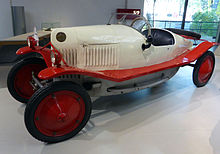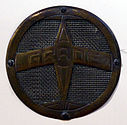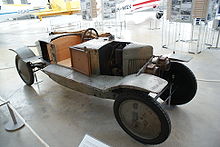Grade automobile plants
| Grade Automobilwerke AG (1921–1925) Grade Automobil AG (1925–1928)
|
|
|---|---|
| legal form | Corporation |
| founding | 1921 |
| resolution | 1928 |
| Seat | Borkheide , Germany |
| management | Hans Grade |
| Branch | Automobile manufacturer |

The Grade Automobil AG , previously grade automobilwerke AG was an automobile manufacturer based in the 1920s -Jahren in Bork (Colony) (now Borkheide ) in Brandenburg small cars produced.
Company history
In 1921, Grade Automobilwerke AG was founded by aircraft designer Hans Grade for the production of small cars - provisions of the Versailles Treaty largely prohibited aircraft construction activities in Germany after the First World War, so that many aircraft manufacturers moved into neighboring areas such as vehicle construction. In the same year, the company presented an open two-seater at the Berlin Motor Show. On March 4, 1924, the completion of the thousandth vehicle was celebrated. In the summer of 1924 financial difficulties arose, after which the company came under business supervision. In 1925 the name was changed to Grade Automobil AG . Production ended in 1928. In total, around 2000 or around 2500 vehicles were built.
At least one vehicle took part in the small car race at the Berlin AVUS in 1923.
In 1977 three existing vehicles were still known.
The Austro-Grade automobile factory from Klosterneuburg in Austria also manufactured automobiles between 1923 and 1926.
vehicles
Grade F 1
The Grade F 1 model presented in 1921 had a single - cylinder two-stroke engine with a 97 mm bore , 120 mm stroke and 887 cm³ displacement , which developed 12 hp . A few copies of this model were produced by the end of 1921.
Grade F 2 and F 2 A
Grade F 2 appeared at the end of 1921 or beginning of 1922 . It had a two-cylinder engine with a 70 mm bore, 105 mm stroke and a displacement of 808 cm³ from its own development. The engine initially made 14 hp, later 16 hp. It was constructed without a chassis, i.e. self-supporting . The drive concept with two-cylinder engine, friction gear and belt drive on the rear axle, which therefore managed without a differential , and the consistent application of the lightweight construction principle bring the 4/16 hp level close to that of the cycle car , even if it was rather large. In 1924, this type was even the most popular small car in Germany.
In 1925 the grade F 2 A followed . His engine with the same dimensions had normal intake ducts instead of the plate valves previously used to control the intake of fresh gases, which was more reliable and easier to operate. The engine output was now 16 hp. The wheelbase was reduced from 295 cm to 290 cm. The track width was still 100 cm. The vehicles were equipped with electric lights and starters.
But when Opel and Hanomag brought their small cars onto the market, the light vehicle with the boat-shaped structure no longer had a chance. The price of 3000 Reichsmarks in 1924 was too high for that, while the Hanomag 2/10 HP was much cheaper.
| Type | Small car 4/16 hp |
| Construction period | 1922-1928 |
| Superstructures | two-seater roadster |
| engine | Two-cylinder in - line engine , two-stroke |
| Valves | without |
| Bore × stroke | 70 mm × 105 mm |
| Displacement | 808 cc |
| power | 10.3-11.8 kW (14-16 hp ) |
| at speed | 1800 min -1 |
| compression | 4.8: 1 |
| consumption | 8 l / 100 km |
| transmission | Friction gear , 4-stage with shift inside left |
| Top speed | 75 km / h |
| Empty weight | 400 kg |
| Electrics | 6 volts |
| length | 3670 mm |
| width | 1250 mm |
| height | 1700 mm (with hood) |
| wheelbase | 2950 mm (1922-1924) 2900 mm (1925-1928) |
| Track width front / rear | 1000 mm / 1000 mm |
| wheel size | 710 × 90 HD |
Grade F 4 A
The degrees F 4 A appeared in 1926. He had a four-cylinder -Zweitaktmotor with 56 mm bore, 100 mm stroke, 980 cc and 24 hp. With a track width of 125 cm, the wheelbase was 300 cm. This model had a differential. The body offered space for four people. Only a few vehicles were produced until 1928.
literature
- Werner Oswald : German Cars 1920–1945. 10th edition. Motorbuch Verlag, Stuttgart 1996, ISBN 3-87943-519-7 .
- Harald H. Linz, Halwart Schrader : The International Automobile Encyclopedia . United Soft Media Verlag, Munich 2008, ISBN 978-3-8032-9876-8 , chapter grade.
- Harald H. Linz, Halwart Schrader: The great automobile encyclopedia. 100 years of history. 2500 brands from 65 countries. 2nd Edition. BLV Buchverlag, Munich, Vienna, Zurich 1992, ISBN 3-405-12974-5 , p. 35.
- George Nick Georgano (Ed.): Complete Encyclopedia of Motorcars, 1885 to the Present. 2nd Edition. Dutton Press, New York 1973, ISBN 0-525-08351-0 . (English)
- Hans-Heinrich von Fersen : The grade wasn't so crooked at all. In: Automobil- und Motorrad-Chronik , issue 8/1977, pp. 11–32.
Web links
- Allcarindex (English)
- Neander driving machine: Darth Vader's helmet on wheels. on: Spiegel Online. (scroll)
- Futurism on Wheels: The Wonder Machines. Fig. 7, on: Spiegel Online.
Individual evidence
- ↑ a b c d e f g h i j k l m n o p Hans-Heinrich von Fersen: The grade wasn't that bad. In: Automobil- und Motorrad-Chronik , issue 8/1977, pp. 11–32.
- ↑ a b c George Nick Georgano (Ed.): Complete Encyclopedia of Motorcars, 1885 to the Present. 2nd Edition. Dutton Press, New York 1973, ISBN 0-525-08351-0 . (English)
- ↑ a b Harald H. Linz, Halwart Schrader : The International Automobile Encyclopedia . United Soft Media Verlag, Munich 2008, ISBN 978-3-8032-9876-8 , chapter grade.
- ^ Hans Christoph von Seherr-Thoss : The German automobile industry. Documentation from 1886 until today . Deutsche Verlags-Anstalt, Stuttgart 1974, ISBN 3-421-02284-4 , p. 235 .
- ↑ a b Harald H. Linz, Halwart Schrader: The great automobile encyclopedia. 100 years of history. 2500 brands from 65 countries. 2nd Edition. BLV Buchverlag, Munich, Vienna, Zurich 1992, ISBN 3-405-12974-5 , p. 35.
- ↑ Spiegel Online: Futurism on Wheels: The Wonder Machines. Fig. 7.


